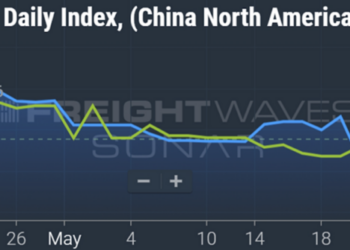Retail diesel prices as measured by the Department of Energy/Energy Information Administration weekly average retail price dropped Monday for the 17th time in 18 weeks.
The price, used as the basis for most fuel surcharges, fell 5.8 cents a gallon to $3.797 a gallon. It’s the lowest weekly price since Jan. 24, 2022.
Since the all-time high price in the series recorded June 20,2023, when it hit $5.81 a gallon, average retail diesel prices as measured by the EIA are down $2.013 a gallon.
The decline came as oil markets were jolted over the weekend by the surprise announcement that Saudi Arabia, acting on its own, would reduce its crude output by 1 million barrels a day beginning July 1.
That news came out of a meeting in Vienna of the OPEC+ group, which includes the members of OPEC and a group of non-OPEC oil exporters, led by Russia, that has been cooperating with OPEC for several years.
Actions taken by OPEC before the formation of OPEC+, and by OPEC+ as a whole, have always been on a coordinated basis. Not every country necessarily did what it was told, or was in agreement with a group decision, but there would be an announcement of what OPEC or OPEC+ planned to do as a group.
The production cut announced by the Saudis at the OPEC meeting in Vienna was notable not only for the quantity — 1 million barrels per day — but the fact that it was undertaken unilaterally. Historically, Saudi Arabia has been the driving force behind the idea that OPEC and more recently the non-OPEC oil exporters that make up the OPEC+ countries, should work in concert.
Various calculations by the media that cover oil markets and OPEC calculate that the move would take Saudi output down to somewhere near 9 million b/d, a level it has not been at since before the financial crisis.
S&P Global Commodity Insights estimated Saudi production in April at 10.5 million b/d. It has not yet given its estimate for May but the OPEC+ nations were to implement reductions in output beginning May 1. Those cuts were to total 1.66 million b/d.
When those cuts were announced in early April, markets moved higher in reaction. The highest settlement on the CME commodity exchange for Brent, the world’s crude benchmark, in the immediate wake of that decision in early April was near $85 a barrel.
But the price of crude has drifted lower since then, with Brent settling last Wednesday at $72.66 a barrel. A leading Saudi official said recently that short sellers in the crude market would suffer “ouching” as a result of upcoming Saudi actions.
Prices have moved higher in recent days. But while oil prices did surge on the news of the unilateral Saudi cut beginning late Sunday night U.S. time when electronic trading began, the rally did not have legs. Brent settled Monday at $76.71 a barrel, up just 58 cents on the day. But it traded as high as $78.72 earlier in the day.
West Texas Intermediate, the U.S. crude benchmark, settled at $76.71 a barrel, up just 41 cents from Friday. But in early trading following the Saudi news out of Vienna, it traded as high as $75.06.
Ultra low sulfur diesel rose slightly more than the crude benchmarks Monday. While WTI was up 0.57% and Brent rose 0.76%, the 2.06-cents-per-gallon increase in ULSD took it up 0.87%.
Saudi frustration with continued stagnation in prices and the failure of Russia to adhere to cuts it had promised were reported to have driven the decision by the kingdom. That frustration comes even as there are other signs in the market that could point to significantly higher prices.
Specifically, the amount of oil that the International Energy Agency says is going to need to be produced by OPEC+ in the fourth quarter is significantly more than what has been produced recently. S&P Global Commodities Insight reported that in February, the last full month for which it has an estimate, OPEC+ output was about 42 million b/d. But the IEA estimate is that OPEC+ would need to produce 45.2 million b/d to balance supply and demand in the fourth quarter.
In the diesel market, inventories of ultra low sulfur diesel continued to drop in the latest weekly report, released on Thursday for the week ended May 26.
Inventories of ULSD for last week did rise to 96.8 million barrels, up from 94.6 million a week earlier. But at that level below 100 million barrels, they have been under that psychological benchmark for several weeks, only the third time in recent years that stocks fell below 100 million barrels. Those other two times were last fall and spring when retail diesel prices were well above $5 a gallon.
One significant difference from a year ago, however: the price of natural gas. The Henry Hub natural gas price a year ago stood at more than $8 per thousand cubic feet (Mcf.) That led to reports of users substituting diesel for natural gas where such a switch was possible.
But with natural gas in the U.S. now at about $2.25 per Mcf, that switch is not likely to occur in 2023.
More articles by John Kingston
Add it up: Fewer truck transportation jobs in May than January
Advanced Clean Fleets rule: Like it or not, it’s time to get ready
TriumphPay pulls in biggest audit and payment network customer so far: WorldWide Express
The post Diesel benchmark down again and Saudi production will be soon appeared first on FreightWaves.














